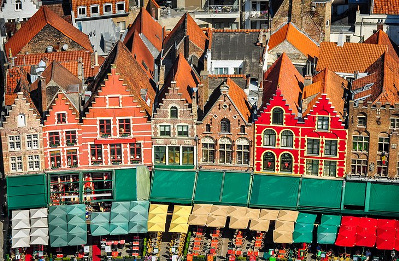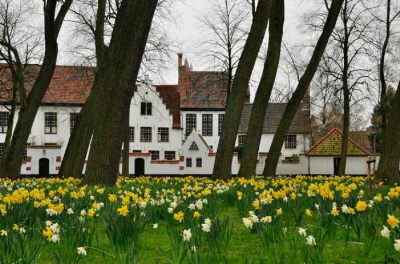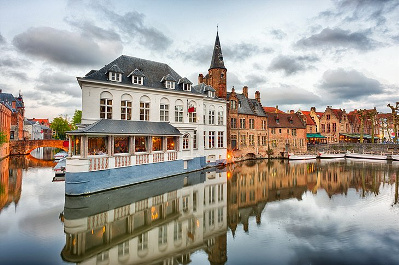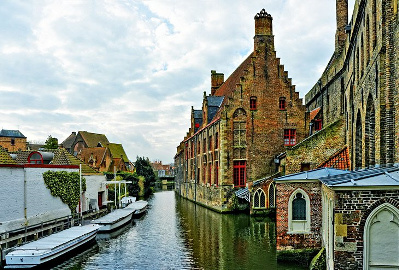Top 10 sites to see
There are dozens of things worth doing and seeing in Bruges, Belgium’s most enchanting city. Here are our picks for the top 10.
1. Belfry & Halle
 The south side of Bruges' Markt (the main square) is dominated by the Halle with the belfry - Bruges' most distinctive landmark - soaring above it. The Halle was begun in 1248 and twice enlarged, first in the 14th century and then again in the 16th century, and once functioned as the city's main market place. The building encloses a picturesque courtyard, and the balcony above the entrance was once used by the city fathers to promulgate their statutes to the populace assembled beneath.
The south side of Bruges' Markt (the main square) is dominated by the Halle with the belfry - Bruges' most distinctive landmark - soaring above it. The Halle was begun in 1248 and twice enlarged, first in the 14th century and then again in the 16th century, and once functioned as the city's main market place. The building encloses a picturesque courtyard, and the balcony above the entrance was once used by the city fathers to promulgate their statutes to the populace assembled beneath.
The 83-meter-high belfry is one of the finest bell towers in Belgium and is entered from the Halle's inner courtyard. Construction of the bell tower began in 1282, and the crowning octagonal upper section was finally completed in 1482. Today, a carillon of 47 bells still hang in the tower. For the best view over Bruges, you can climb the 366 steps up to the top of the tower. On the way up, the old Treasure Room where civic documents are kept behind wrought-iron grills can be visited on the second floor.
2. Markt
 At the very heart of the city is the Markt; Bruges' bustling main square, surrounded on all sides by fine buildings from a variety of different periods. The eastern side is dominated by the Neo-Gothic Provinciaal Hof building which dates from 1887 and is the seat of the West-Vlaanderen provincial government. On the western side, occupying the left-hand corner, is the attractive brick 15th Century Huis Bouchoute. On the opposite corner stands the Craenenburg where, in 1488, at the instigation of Ghent, the burghers of Bruges kept the future Habsburg Emperor Maximilian imprisoned for 11 weeks. He was freed only after agreeing to respect the authority of the ruling Regency Council and to order the withdrawal of all foreign troops. The best way to admire all this architectural finery is to join the throngs of visitors and locals at one of the Markt's many cafés and sit for a while soaking up the historic splendour around you.
At the very heart of the city is the Markt; Bruges' bustling main square, surrounded on all sides by fine buildings from a variety of different periods. The eastern side is dominated by the Neo-Gothic Provinciaal Hof building which dates from 1887 and is the seat of the West-Vlaanderen provincial government. On the western side, occupying the left-hand corner, is the attractive brick 15th Century Huis Bouchoute. On the opposite corner stands the Craenenburg where, in 1488, at the instigation of Ghent, the burghers of Bruges kept the future Habsburg Emperor Maximilian imprisoned for 11 weeks. He was freed only after agreeing to respect the authority of the ruling Regency Council and to order the withdrawal of all foreign troops. The best way to admire all this architectural finery is to join the throngs of visitors and locals at one of the Markt's many cafés and sit for a while soaking up the historic splendour around you.
3. Basilica of the Holy Blood
 The Basilica of the Holy Blood in Bruges houses nothing less than a relic of Christ himself: his very blood, collected by Joseph of Arimathea and brought to Belgium from the Holy Land. It sounds deeply religious, and Christian visitors will feel that way. However, the basilica is also worth experiencing regardless of faith, as it is stunning in its simplicity, its masterly decorations and historic value. It consists of two chapels; the one on the lower level is austere with very little decoration. Meanwhile the Gothic upper level is alive with color and detail. Every day at fixed hours, the cloth with the holy blood of Christ is revered and visitors can queue up to touch or kiss it, and feel utterly blessed.
The Basilica of the Holy Blood in Bruges houses nothing less than a relic of Christ himself: his very blood, collected by Joseph of Arimathea and brought to Belgium from the Holy Land. It sounds deeply religious, and Christian visitors will feel that way. However, the basilica is also worth experiencing regardless of faith, as it is stunning in its simplicity, its masterly decorations and historic value. It consists of two chapels; the one on the lower level is austere with very little decoration. Meanwhile the Gothic upper level is alive with color and detail. Every day at fixed hours, the cloth with the holy blood of Christ is revered and visitors can queue up to touch or kiss it, and feel utterly blessed.
4. The “Ten Wijngaerde” Béguinage
 Imagine yourself back in time, in a place of peace and tranquility at The Béguinage in Bruges. Tiny white plastered houses surround a courtyard where yellow daffodils bloom in spring and the occasional nun hurries towards the chapel when mass is about to begin. This béguinage was founded in 1245, and still resembles medieval times. This pure, untouched part of Bruges is perfect to unwind, leave behind the city’s buzz for one beautiful moment and become totally zen.
Imagine yourself back in time, in a place of peace and tranquility at The Béguinage in Bruges. Tiny white plastered houses surround a courtyard where yellow daffodils bloom in spring and the occasional nun hurries towards the chapel when mass is about to begin. This béguinage was founded in 1245, and still resembles medieval times. This pure, untouched part of Bruges is perfect to unwind, leave behind the city’s buzz for one beautiful moment and become totally zen.
5. Town Hall
 On the southeast side of the Burg is Bruges' Town Hall (Stadhuis), one of the oldest in Belgium, having been constructed between 1376 and 1420. The facade of the delicate Gothic building displays the strong vertical emphasis characteristic of the style, with soaring pilasters, three of which end in octagonal turrets, separated by tall Gothic arched windows. Statues of the counts of Flanders from Baldwin Iron Arm onwards fill the 49 niches. Inside, don't miss the great Gothic Hall on the first floor with its beautiful timber vaulting, which dates from 1402, and its murals recording events in the town's history by A and J de Vriendt (1895-1900).
On the southeast side of the Burg is Bruges' Town Hall (Stadhuis), one of the oldest in Belgium, having been constructed between 1376 and 1420. The facade of the delicate Gothic building displays the strong vertical emphasis characteristic of the style, with soaring pilasters, three of which end in octagonal turrets, separated by tall Gothic arched windows. Statues of the counts of Flanders from Baldwin Iron Arm onwards fill the 49 niches. Inside, don't miss the great Gothic Hall on the first floor with its beautiful timber vaulting, which dates from 1402, and its murals recording events in the town's history by A and J de Vriendt (1895-1900).
6. Liberty of Bruges
 In the east side of the Burg, the Bruges Tourist Office occupies part of what was, up until 1984, the Law Courts, built between 1722 and 1727 on the site of the former Liberty of Bruges (Paleis van het Brugse Vrije) from where independent magistrates exercised jurisdiction over the region. Some fragments of the older building have survived, including the pretty 16th-century facade overlooking the canal at the rear. One or two of the more historic rooms inside are now the Brugse Vrije Museum and can be admired by visitors. Of particular interest is the Schepenzaal (lay magistrates' court) where you can see the famous chimneypiece designed by the painter Lanceloot Blondeel in 1529 and executed in black marble and oak by Guyot de Beaugrant. This magnificent piece of Renaissance craftsmanship has an alabaster frieze above depicting the story of Susanna and the Elders with carved oak figures of the Emperor Charles V and his parents, Ferdinand and Isabella of Castille, Mary of Burgundy, and Maximilian.
In the east side of the Burg, the Bruges Tourist Office occupies part of what was, up until 1984, the Law Courts, built between 1722 and 1727 on the site of the former Liberty of Bruges (Paleis van het Brugse Vrije) from where independent magistrates exercised jurisdiction over the region. Some fragments of the older building have survived, including the pretty 16th-century facade overlooking the canal at the rear. One or two of the more historic rooms inside are now the Brugse Vrije Museum and can be admired by visitors. Of particular interest is the Schepenzaal (lay magistrates' court) where you can see the famous chimneypiece designed by the painter Lanceloot Blondeel in 1529 and executed in black marble and oak by Guyot de Beaugrant. This magnificent piece of Renaissance craftsmanship has an alabaster frieze above depicting the story of Susanna and the Elders with carved oak figures of the Emperor Charles V and his parents, Ferdinand and Isabella of Castille, Mary of Burgundy, and Maximilian.
7. Groeninge Museum
 Head to the Dijver Canal, to visit the Groeninge Museum (Stedelijk Museum voor Schone Kunst), which holds Bruges' best collection of art. In addition to its excellent endowment of Old Flemish paintings, the museum also incorporates a gallery of modern art and a superb collection of views of old Bruges. However, the first five rooms of the museum are the ones most likely to claim your attention as they contain quite exceptional paintings by Old Flemish masters. In Room 1 hang two major works by Jan van Eyck: Madonna and the donor, Canon van der Paele (1436) and the portrait of Margaret van Eyck, the artist's wife, painted when she was 33 years of age (1439). In Room 3 are panels illustrating the legend of St. Ursula and a portrait of Luis Gruuthuse, both famous works by unknown Bruges masters, and the Last Judgment by Hieronymus Bosch is among the paintings in Room 5.
Head to the Dijver Canal, to visit the Groeninge Museum (Stedelijk Museum voor Schone Kunst), which holds Bruges' best collection of art. In addition to its excellent endowment of Old Flemish paintings, the museum also incorporates a gallery of modern art and a superb collection of views of old Bruges. However, the first five rooms of the museum are the ones most likely to claim your attention as they contain quite exceptional paintings by Old Flemish masters. In Room 1 hang two major works by Jan van Eyck: Madonna and the donor, Canon van der Paele (1436) and the portrait of Margaret van Eyck, the artist's wife, painted when she was 33 years of age (1439). In Room 3 are panels illustrating the legend of St. Ursula and a portrait of Luis Gruuthuse, both famous works by unknown Bruges masters, and the Last Judgment by Hieronymus Bosch is among the paintings in Room 5.
8. Church of Our Lady
 The 112-meter-high spire of the Church of Our Lady (Onze Lieve Vrouwekerk) is the tallest in Belgium. Work began on the nave and aisles around 1230, the outermost aisles and chapels being added in the 14th and 15th centuries. The church holds a wealth of art treasures, among which is a sublime sculpture by Michelangelo, Virgin and Child (1503-04). The sculpture stands on the altar of the chapel at the end of the south aisle. The Calvary on the high altar is by Bernaert van Orley, the triptych Adoration of the Shepherds is by Pieter Pourbus, and the Transfiguration of Christ is by Gerard David.
The 112-meter-high spire of the Church of Our Lady (Onze Lieve Vrouwekerk) is the tallest in Belgium. Work began on the nave and aisles around 1230, the outermost aisles and chapels being added in the 14th and 15th centuries. The church holds a wealth of art treasures, among which is a sublime sculpture by Michelangelo, Virgin and Child (1503-04). The sculpture stands on the altar of the chapel at the end of the south aisle. The Calvary on the high altar is by Bernaert van Orley, the triptych Adoration of the Shepherds is by Pieter Pourbus, and the Transfiguration of Christ is by Gerard David.
9. Memling Museum
 In the Memling Museum, six exquisite masterpieces by Hans Memling (ca. 1430-94) are on view, each a pearl of Old Flemish art. Outstanding even among these is the Reliquary of St. Ursula (1489), recognized as one of the master's most important works. Scarcely less famous is the Mystic Marriage of St. Catherine, painted for the so-called St. John altar. Completed in 1479, it depicts Saints Barbara and Catherine flanked by St. John the Baptist and St. John the Evangelist. The four other works by Memling in the museum are the Maarten van Nieuwenhove diptych of 1487 (with the Virgin handing the Christ child an apple on one wing, and a superb portrait of the donor on the other ), a triptych (1479) with the Adoration of the Magi and the donor Jan Floreins, another triptych with the Descent from the Cross (1480) and finally, the portrait of Sibylla Zambetha (1480).
In the Memling Museum, six exquisite masterpieces by Hans Memling (ca. 1430-94) are on view, each a pearl of Old Flemish art. Outstanding even among these is the Reliquary of St. Ursula (1489), recognized as one of the master's most important works. Scarcely less famous is the Mystic Marriage of St. Catherine, painted for the so-called St. John altar. Completed in 1479, it depicts Saints Barbara and Catherine flanked by St. John the Baptist and St. John the Evangelist. The four other works by Memling in the museum are the Maarten van Nieuwenhove diptych of 1487 (with the Virgin handing the Christ child an apple on one wing, and a superb portrait of the donor on the other ), a triptych (1479) with the Adoration of the Magi and the donor Jan Floreins, another triptych with the Descent from the Cross (1480) and finally, the portrait of Sibylla Zambetha (1480).
10. Sint-Jansspitaal
 Immediately opposite the west door of the Church of Our Lady stands the oldest building in Bruges, the Sint-Jansspitaal founded in the 12th century. Look up at the tympanum, over the bricked up gate to the left of the Mariastraat entrance, embellished with reliefs showing the Virgin, which bears the date 1270. Inside the ancient building, in what were once wards, an exhibition of documents and surgical instruments charts the hospital's history. The old dispensary adjacent to the wards has also been preserved. South of Sint-Jansspitaal is the street of Walstraat rimmed by tiny, exceptionally pretty, gabled 16th- and 17th-century houses in which lacemakers still practice their craft.
Immediately opposite the west door of the Church of Our Lady stands the oldest building in Bruges, the Sint-Jansspitaal founded in the 12th century. Look up at the tympanum, over the bricked up gate to the left of the Mariastraat entrance, embellished with reliefs showing the Virgin, which bears the date 1270. Inside the ancient building, in what were once wards, an exhibition of documents and surgical instruments charts the hospital's history. The old dispensary adjacent to the wards has also been preserved. South of Sint-Jansspitaal is the street of Walstraat rimmed by tiny, exceptionally pretty, gabled 16th- and 17th-century houses in which lacemakers still practice their craft.